Jeff Rasley
DeepSpeed-FastGen: High-throughput Text Generation for LLMs via MII and DeepSpeed-Inference
Jan 09, 2024Abstract:The deployment and scaling of large language models (LLMs) have become critical as they permeate various applications, demanding high-throughput and low-latency serving systems. Existing frameworks struggle to balance these requirements, especially for workloads with long prompts. This paper introduces DeepSpeed-FastGen, a system that employs Dynamic SplitFuse, a novel prompt and generation composition strategy, to deliver up to 2.3x higher effective throughput, 2x lower latency on average, and up to 3.7x lower (token-level) tail latency, compared to state-of-the-art systems like vLLM. We leverage a synergistic combination of DeepSpeed-MII and DeepSpeed-Inference to provide an efficient and easy-to-use serving system for LLMs. DeepSpeed-FastGen's advanced implementation supports a range of models and offers both non-persistent and persistent deployment options, catering to diverse user scenarios from interactive sessions to long-running applications. We present a detailed benchmarking methodology, analyze the performance through latency-throughput curves, and investigate scalability via load balancing. Our evaluations demonstrate substantial improvements in throughput and latency across various models and hardware configurations. We discuss our roadmap for future enhancements, including broader model support and new hardware backends. The DeepSpeed-FastGen code is readily available for community engagement and contribution.
DeepSpeed4Science Initiative: Enabling Large-Scale Scientific Discovery through Sophisticated AI System Technologies
Oct 11, 2023



Abstract:In the upcoming decade, deep learning may revolutionize the natural sciences, enhancing our capacity to model and predict natural occurrences. This could herald a new era of scientific exploration, bringing significant advancements across sectors from drug development to renewable energy. To answer this call, we present DeepSpeed4Science initiative (deepspeed4science.ai) which aims to build unique capabilities through AI system technology innovations to help domain experts to unlock today's biggest science mysteries. By leveraging DeepSpeed's current technology pillars (training, inference and compression) as base technology enablers, DeepSpeed4Science will create a new set of AI system technologies tailored for accelerating scientific discoveries by addressing their unique complexity beyond the common technical approaches used for accelerating generic large language models (LLMs). In this paper, we showcase the early progress we made with DeepSpeed4Science in addressing two of the critical system challenges in structural biology research.
DeepSpeed-Chat: Easy, Fast and Affordable RLHF Training of ChatGPT-like Models at All Scales
Aug 02, 2023
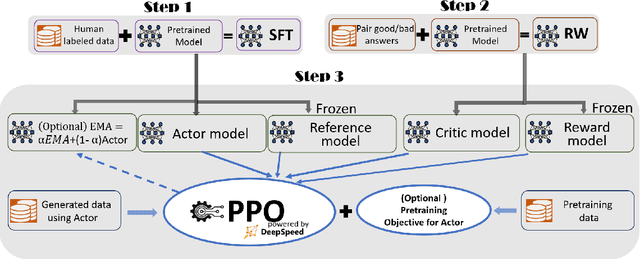

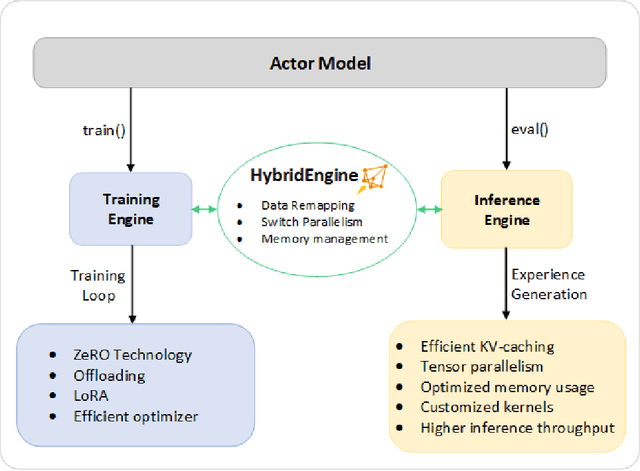
Abstract:ChatGPT-like models have revolutionized various applications in artificial intelligence, from summarization and coding to translation, matching or even surpassing human performance. However, the current landscape lacks an accessible, efficient, and cost-effective end-to-end RLHF (Reinforcement Learning with Human Feedback) training pipeline for these powerful models, particularly when training at the scale of billions of parameters. This paper introduces DeepSpeed-Chat, a novel system that democratizes RLHF training, making it accessible to the AI community. DeepSpeed-Chat offers three key capabilities: an easy-to-use training and inference experience for ChatGPT-like models, a DeepSpeed-RLHF pipeline that replicates the training pipeline from InstructGPT, and a robust DeepSpeed-RLHF system that combines various optimizations for training and inference in a unified way. The system delivers unparalleled efficiency and scalability, enabling training of models with hundreds of billions of parameters in record time and at a fraction of the cost. With this development, DeepSpeed-Chat paves the way for broader access to advanced RLHF training, even for data scientists with limited resources, thereby fostering innovation and further development in the field of AI.
MCR-DL: Mix-and-Match Communication Runtime for Deep Learning
Mar 15, 2023



Abstract:In recent years, the training requirements of many state-of-the-art Deep Learning (DL) models have scaled beyond the compute and memory capabilities of a single processor, and necessitated distribution among processors. Training such massive models necessitates advanced parallelism strategies to maintain efficiency. However, such distributed DL parallelism strategies require a varied mixture of collective and point-to-point communication operations across a broad range of message sizes and scales. Examples of models using advanced parallelism strategies include Deep Learning Recommendation Models (DLRM) and Mixture-of-Experts (MoE). Communication libraries' performance varies wildly across different communication operations, scales, and message sizes. We propose MCR-DL: an extensible DL communication framework that supports all point-to-point and collective operations while enabling users to dynamically mix-and-match communication backends for a given operation without deadlocks. MCR-DL also comes packaged with a tuning suite for dynamically selecting the best communication backend for a given input tensor. We select DeepSpeed-MoE and DLRM as candidate DL models and demonstrate a 31% improvement in DS-MoE throughput on 256 V100 GPUs on the Lassen HPC system. Further, we achieve a 20% throughput improvement in a dense Megatron-DeepSpeed model and a 25% throughput improvement in DLRM on 32 A100 GPUs with the Theta-GPU HPC system.
BLOOM: A 176B-Parameter Open-Access Multilingual Language Model
Nov 09, 2022Abstract:Large language models (LLMs) have been shown to be able to perform new tasks based on a few demonstrations or natural language instructions. While these capabilities have led to widespread adoption, most LLMs are developed by resource-rich organizations and are frequently kept from the public. As a step towards democratizing this powerful technology, we present BLOOM, a 176B-parameter open-access language model designed and built thanks to a collaboration of hundreds of researchers. BLOOM is a decoder-only Transformer language model that was trained on the ROOTS corpus, a dataset comprising hundreds of sources in 46 natural and 13 programming languages (59 in total). We find that BLOOM achieves competitive performance on a wide variety of benchmarks, with stronger results after undergoing multitask prompted finetuning. To facilitate future research and applications using LLMs, we publicly release our models and code under the Responsible AI License.
DeepSpeed Inference: Enabling Efficient Inference of Transformer Models at Unprecedented Scale
Jun 30, 2022

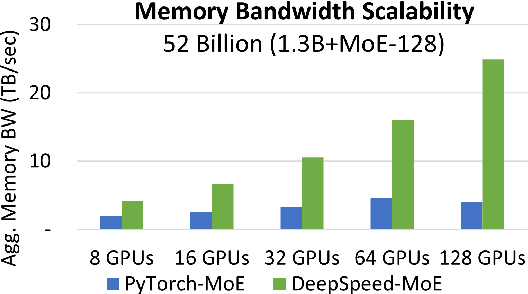
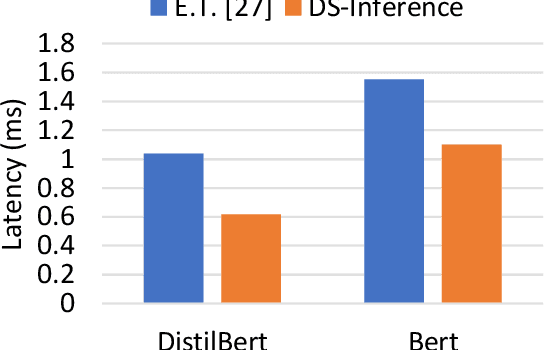
Abstract:The past several years have witnessed the success of transformer-based models, and their scale and application scenarios continue to grow aggressively. The current landscape of transformer models is increasingly diverse: the model size varies drastically with the largest being of hundred-billion parameters; the model characteristics differ due to the sparsity introduced by the Mixture-of-Experts; the target application scenarios can be latency-critical or throughput-oriented; the deployment hardware could be single- or multi-GPU systems with different types of memory and storage, etc. With such increasing diversity and the fast-evolving pace of transformer models, designing a highly performant and efficient inference system is extremely challenging. In this paper, we present DeepSpeed Inference, a comprehensive system solution for transformer model inference to address the above-mentioned challenges. DeepSpeed Inference consists of (1) a multi-GPU inference solution to minimize latency while maximizing the throughput of both dense and sparse transformer models when they fit in aggregate GPU memory, and (2) a heterogeneous inference solution that leverages CPU and NVMe memory in addition to the GPU memory and compute to enable high inference throughput with large models which do not fit in aggregate GPU memory. DeepSpeed Inference reduces latency by up to 7.3X over the state-of-the-art for latency-oriented scenarios and increases throughput by over 1.5x for throughput-oriented scenarios. Moreover, it enables trillion parameter scale inference under real-time latency constraints by leveraging hundreds of GPUs, an unprecedented scale for inference. It can inference 25x larger models than with GPU-only solutions, while delivering a high throughput of 84 TFLOPS (over $50\%$ of A6000 peak).
DeepSpeed-MoE: Advancing Mixture-of-Experts Inference and Training to Power Next-Generation AI Scale
Jan 14, 2022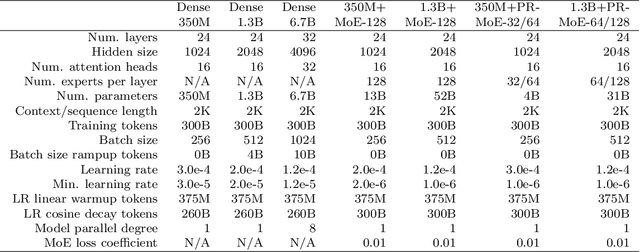
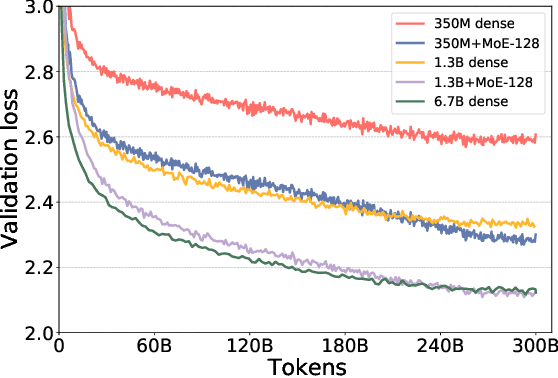

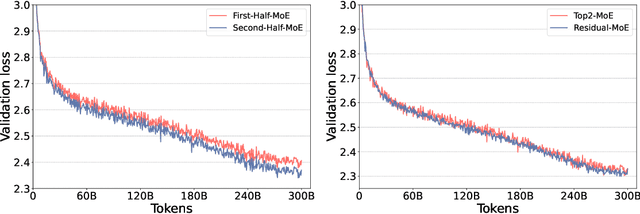
Abstract:As the training of giant dense models hits the boundary on the availability and capability of the hardware resources today, Mixture-of-Experts (MoE) models become one of the most promising model architectures due to their significant training cost reduction compared to a quality-equivalent dense model. Its training cost saving is demonstrated from encoder-decoder models (prior works) to a 5x saving for auto-aggressive language models (this work along with parallel explorations). However, due to the much larger model size and unique architecture, how to provide fast MoE model inference remains challenging and unsolved, limiting its practical usage. To tackle this, we present DeepSpeed-MoE, an end-to-end MoE training and inference solution as part of the DeepSpeed library, including novel MoE architecture designs and model compression techniques that reduce MoE model size by up to 3.7x, and a highly optimized inference system that provides 7.3x better latency and cost compared to existing MoE inference solutions. DeepSpeed-MoE offers an unprecedented scale and efficiency to serve massive MoE models with up to 4.5x faster and 9x cheaper inference compared to quality-equivalent dense models. We hope our innovations and systems help open a promising path to new directions in the large model landscape, a shift from dense to sparse MoE models, where training and deploying higher-quality models with fewer resources becomes more widely possible.
ZeRO-Infinity: Breaking the GPU Memory Wall for Extreme Scale Deep Learning
Apr 16, 2021



Abstract:In the last three years, the largest dense deep learning models have grown over 1000x to reach hundreds of billions of parameters, while the GPU memory has only grown by 5x (16 GB to 80 GB). Therefore, the growth in model scale has been supported primarily though system innovations that allow large models to fit in the aggregate GPU memory of multiple GPUs. However, we are getting close to the GPU memory wall. It requires 800 NVIDIA V100 GPUs just to fit a trillion parameter model for training, and such clusters are simply out of reach for most data scientists. In addition, training models at that scale requires complex combinations of parallelism techniques that puts a big burden on the data scientists to refactor their model. In this paper we present ZeRO-Infinity, a novel heterogeneous system technology that leverages GPU, CPU, and NVMe memory to allow for unprecedented model scale on limited resources without requiring model code refactoring. At the same time it achieves excellent training throughput and scalability, unencumbered by the limited CPU or NVMe bandwidth. ZeRO-Infinity can fit models with tens and even hundreds of trillions of parameters for training on current generation GPU clusters. It can be used to fine-tune trillion parameter models on a single NVIDIA DGX-2 node, making large models more accessible. In terms of training throughput and scalability, it sustains over 25 petaflops on 512 NVIDIA V100 GPUs(40% of peak), while also demonstrating super linear scalability. An open source implementation of ZeRO-Infinity is available through DeepSpeed, a deep learning optimization library that makes distributed training easy, efficient, and effective.
ZeRO: Memory Optimization Towards Training A Trillion Parameter Models
Oct 07, 2019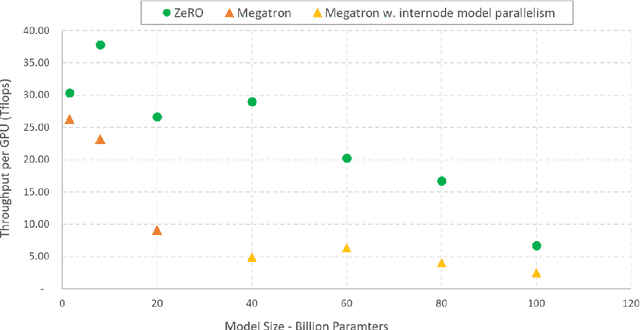

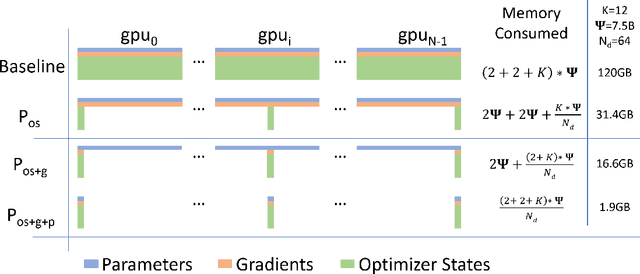

Abstract:Training large DL models with billions and potentially trillions of parameters is challenging. Existing solutions exhibit fundamental limitations to obtain both memory and scaling (computation/communication) efficiency together. Data parallelism does not help reduce memory footprint per device: a model with 1.5 billion parameters or more runs out of memory. Model parallelism hardly scales efficiently beyond multiple devices of a single node due to fine-grained computation and expensive communication. We develop a novel solution, Zero Redundancy Optimizer (ZeRO), to optimize memory, achieving both memory efficiency and scaling efficiency. Unlike basic data parallelism where memory states are replicated across data-parallel processes, ZeRO partitions model states instead, to scale the model size linearly with the number of devices. Furthermore, it retains scaling efficiency via computation and communication rescheduling and by reducing the model parallelism degree required to run large models. Our analysis on memory requirements and communication volume demonstrates: ZeRO has the potential to scale beyond 1 Trillion parameters using today's hardware (e.g., 1024 GPUs, 64 DGX-2 nodes). To meet near-term scaling goals and serve as a demonstration of ZeRO's capability, we implemented stage-1 optimizations of ZeRO (out of 3 stages in total described in the paper) and tested this ZeRO-OS version. ZeRO-OS reduces memory and boosts model size by 4x compared with the state-of-art, scaling up to 100B parameters. Moving forward, we will work on unlocking stage-2 optimizations, with up to 8x memory savings per device, and ultimately stage-3 optimizations, reducing memory linearly with respect to the number of devices and potentially scaling to models of arbitrary size. We are excited to transform very large models from impossible to train to feasible and efficient to train!
 Add to Chrome
Add to Chrome Add to Firefox
Add to Firefox Add to Edge
Add to Edge